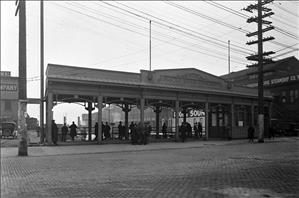On July 3, 1920, the City of Seattle opens a Naval Shore Station at the foot of Washington Street. Built for use by naval vessels, the station also acts as moorage for the city's harbor patrol. Fronted by a wide wrought-iron pergola, the slip provides more than 300 feet of berthage. In the 1970s, the aging pergola will be threatened with demolition, but will be saved by the all-woman Committee of 33, a philanthropic organization. Restored to its former glory, the newly renamed Washington Street Public Boat Landing Facility will be added to the National Register of Historic Places in 1974.
Working in Cooperation
During World War I, the City of Seattle's harbormaster and port warden, Captain A. A. Paysse, worked closely with the United States Navy. As part of the war effort, the navy loaned his organization one of its vessels for use as a patrol boat, as well as a machine gun mounted on another patrol boat, and a searchlight for harbor department headquarters at Pier 1. Captain Paysse, in return, sped up installation of the harbor department's wireless station and established landing floats at Pier 1 for the fleet. After the war, Paysse offered to build a boat landing for visiting naval vessels. By this time, Seattle's waterfront was becoming crowded with commercial traffic, and moorage for the navy was hard to come by.
In the spring of 1920, work began on the naval station at the foot of Washington Street. On the south side of the station's long slip, a 240-foot float would be used for enlisted men's barges, and on the north side, an 82-foot float would be used for officer's barges. More than 80 feet of additional space was provided for other vessels, including the harbor patrol. Gracing the station was an 86-foot-wide wrought-iron pergola designed by city architect Daniel R. Huntington (1871-1962). Besides being utilitarian, the structure added a decorative element to the waterfront, and would soon become a welcome gateway for numerous mariners.
Dedication Day
On July 3, 1920, a few hundred citizens gathered to witness the naval station's dedication. The front of the station was draped in flags and in red, white, and blue bunting. At 2:00 p.m. city councilmember John E. Carroll (1878-1955) called the gathering to order and introduced former Port Warden Captain A. A. Paysse, who had recently retired. Captain Paysse gave a brief history of the station project, beginning with his time in office. Seattle City Attorney Walter F. Meier spoke next, representing Mayor Hugh Caldwell (1882-1955), who could not attend. Meier spoke of the close working relationship between the city and the United States Navy, and then welcomed to the podium Rear Admiral Harry A Field, commandant of the 13th Naval district.
Admiral Field accepted the station on behalf of the navy to thunderous applause. Field marveled at the beautiful new station and noted that it was a welcome addition to the waterfront for smaller boats, whose crews had to do some "tall scrambling to get ashore" at the larger, commercial piers. Field thanked the city for "building this landing for the convenience and comfort of navy personnel" (The Seattle Times, July 3, 1920). The formal dedication of the station commenced with the raising of a huge navy flag, accompanied by the navy yard band playing the national anthem. Later the flag was lowered and replaced with a smaller city-owned flag.

